Fuels and fuel efficiency: Topping up the bottom line
30 September 2019

Increasingly, those who deny the importance of environmental concerns in construction are finding themselves in an untenable position. Equally, however, with economic and political instability rife in Europe, it’s hard to deny that the top priority is still the bottom line.
Fortunately, there is a growing sense that ‘going green’ can sit comfortably with making a profit, at least where fuel is concerned.
Advances in fuel technology and fuel science, partly driven by EU directives, have given rise to construction equipment boasting lower or even zero emissions, with equivalent performance and, potentially, lower lifetime costs.
Equipment using electric propulsion or biofuels is making headlines at the moment, but on the vast majority of jobsites, diesel-fuelled equipment is still standard. It’s here that fuel choices and fuel management are becoming increasingly important.
Shell Commercial Fuels recently released an article based on a global survey conducted with 500 fuel decision makers. In it, the company suggested that fuel – potentially accounting for one fifth or more of operating costs – is not being properly managed.
Close to half of those surveyed by Shell (44%) admitted that their fuel choices had contributed to unplanned downtime. Only 16% of respondents said they manage their fuel ‘very effectively’.
According to Shell, this seemingly glaring error in efficiency can be addressed very simply – potentially requiring nothing more than adopting a better maintenance strategy. This, says Shell, begins with purchasing high-quality additivated diesel, followed by implementing an effective fuel housekeeping regime – from correct storage, through to effective handling and the requisite training.

According to Rebecca Swann of Certas, the air quality benefits of GTL fuel are proven
In its Top Tips for Implementing Effective Fuel Management, Shell encourges regular staff training (particularly in relation to fuel storage and handling), connecting with fuel experts to help implement effective fuel management strategies, and using additivated diesel.
Reducing emissions
Rebecca Swann, a product manager at energy company Certas, describes the difficulties of reducing emissions for an industry almost entirely powered by diesel.
She says, “NRMM [non-road mobile machinery] requires the sudden and powerful burst of energy that is delivered by the combustion of diesel, so it can be difficult to change to other energy sources that can pack the same punch.
“In the case of GTL [gas to liquid], part
of the paraffinic family of fuels, the air quality benefits have been proven for NRMM.
This particular formulation is based on gasification chemistry and can achieve similar performance levels to diesel while reducing emissions of NOx, PM and carbon monoxide.
“Paraffinic fuels could also prove to be more cost-effective than other alternatives, with drop-in technologies such as GTL requiring no engine modifications to existing or legacy NRMM.”
In terms of the industry’s goal of reducing – and ultimately eradicating harmful emissions – Swann’s outlook is pragmatic. She says, “The transition to cleaner air and lower emissions is a journey. There is no silver bullet solution, but rather a variety of fuels that can help construction businesses make an immediate difference today as part of the longer-term transformation route to net-zero.”
She adds, however, that “It’s possible that the quick wins offered by alternative liquid fuels are being overlooked because of an over-emphasis on the zero-emission end goal. Naturally, that is where we all want to be. However, without embracing evolving enhancements in fuel technology, the truth is it will take us much longer to get there.”
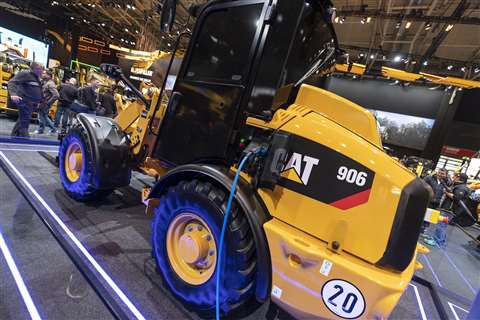
Caterpillar’s Peter-Valentin Sauter has talked previously in Construction Europe about the factors that can affect fuel efficiency.
He has also described ‘five pillars’ on which Caterpillar basis its fuel efficiency ideology.
In simple terms, they are:
- · The reduction of idle time
- · Improving the technique of operators
- · Selecting the most efficient equipment for the job
- · Best use of on board and remote technology
- · Efficient jobsite preparation (including the storage, management and analysis of fuels)
Clearly, these are valuable rules, with the potential to produce significant reductions in diesel usage. In the past 12 months, however, a large number of fully-electric construction machines have gone into production, which brings another dimension to the question of fuel efficiency – especially looking ahead to construction sites of the future.
Added to this, many manufacturers have opted to examine the benefits of alternative fuels, such as liquid natural gas, hydrogen cells, or synthetic and bio-fuels.
For example, while other companies unveiled fully-electric mini excavators at this year’s Bauma in Munich, Kubota launched its KX019-4 LPG – a liquid petrol gas prototype.
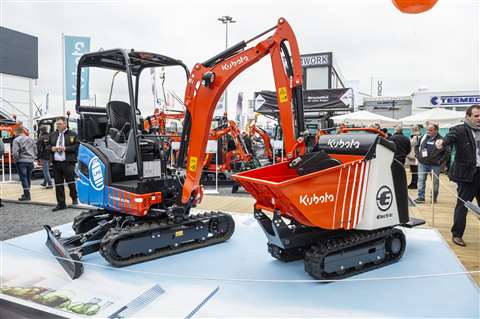
The excavator is able to work in emission restricted access areas such as cities applying diesel bans and is quieter than a standard diesel machine. Using readily-available industrial standard gas bottles, the machine can be quickly refuelled and is equipped with a reserve tank (gas accumulator).
Kubota says there is no reduction in performance with the LPG machine, which is able, with its variable undercarriage, to operate in areas with less than 1m of access.
Keigo Watanabe, VP of Kubota’s sales and marketing business unit in Europe, said, “The development of this model is the answer from Kubota to the current anti-diesel trend, in which economy, practicality and environmental issues are all integrated. This machine, powered by the Kubota SI engine, will bring the most productive solution to urban work sites without having a considerable impact on the investment, or loss of productivity due to the refuelling time.”
Sustainable fuel
When Case Construction unveiled its concept wheeled loader, Project Tetra, at this year’s Bauma, the company’s president, Carl Gustav Göransson, said, “We’ve been researching sustainable fuel sources for our construction machinery for many years. Bio-methane was the most logical choice for the wheeled loader. The fuel needed to be readily available, easy to refuel and power through a full day’s work.
“We were fortunate to work very closely with sister brand FPT Industrial, which has produced over 40,000 gas-powered engines to date. This technology is already tried and tested; there are 28,000 methane-powered Iveco trucks and buses on the roads today.”
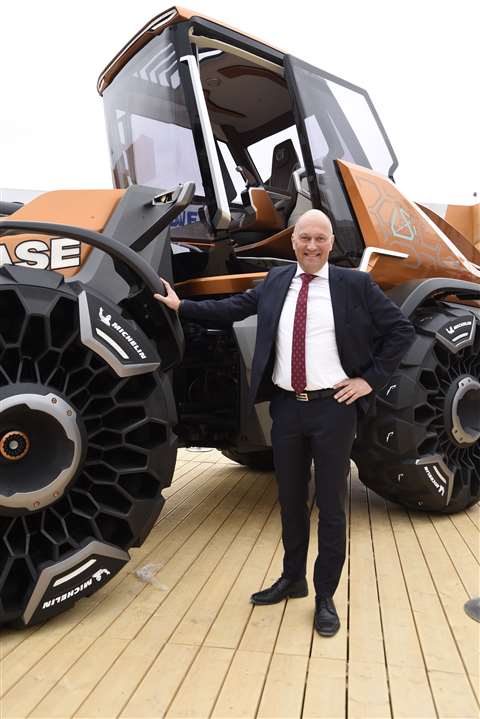
Hubertus Mühlhäuser, CEO of Case’s parent company, CNH Industrial, reinforced Göransson’s message, and even took something of a swipe at full-electric machines, saying, “LNG, CNG and biomethane is the way forward. Biomethane is derived from bio sources, which means you can take more CO₂ out of the atmosphere than you can with electric engines. This technology is going to revolutionise the world. We are already seeing three-digit growth in LNG, year on year.
“With biomethane, over LNG or CNG, vehicles can actually clean the atmosphere, as you are capturing methane from bio sources.”
While a number of companies are pushing forward with bio and synthetic fuel alternatives, the push towards electric propulsion – at least for urban construction equipment – is undeniable.
Many will cite the extra initial outlay on an electric machine as a reason to stick with a diesel equivalent, but those working in inner-city or urban environments may see the change as inevitable and might also look at recouping those initial costs over the lifetime of the equipment.
Bobcat introduced its E10e electric mini-excavator just five months ago and recently announced that all models of the 1 tonne machine had sold out.
Jarry Fiser, mini-excavator product line director at Doosan Bobcat EMEA, said, “We are very pleased that actual demand is higher than our original expectations and production capacities. We prioritised Bobcat dealers in the Netherlands, the Nordic countries, Germany and Austria. These countries have very positive public acceptance of alternative power sources.”
He added, “The E10e is just the start of our journey in further expanding our portfolio in alternative power sources. In essence, all the components in the power train are made to measure and we are still adjusting the processes with our suppliers so that we can increase the production volumes when needed. The 2019 production capacity is already sold out and we are accepting orders for delivery in 2020.”
Creating the market
Volvo President, Melker Jernberg, knows the electric market has some way to go before it fully develops. With the introduction of an electric excavator and an electric wheeled loader earlier this year, he said, “What we are doing is looking to create this market. We are taking this decision for other reasons than purely looking at an excel sheet and the numbers. We really believe in this.
“We can look at the numbers, but at some point we need to decide that this is the right time to act and we believe that the technology is now mature enough to do this. We believe a market will be able to be created.”
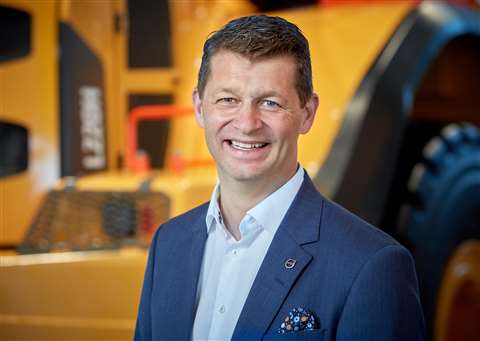
Volvo’s new electric range promises to deliver zero exhaust emissions, lower noise levels, reduced energy costs, improved efficiency and less maintenance requirements, compared with its conventional counterparts.
The ECR25 excavator and L25 loader are powered by lithium-ion batteries, which store enough electric energy to power the machines for around eight hours. Both the ECR25 and L25 have onboard chargers that enable overnight charging via a regular household plug socket.
Volvo said a number of machines will be used and tested by customers in pilot projects before production begins in mid-2020.
Cat is another company that has a well-defined philosophy regarding electrification and has a range of new products in the full-electric, diesel-electric and hybrid arenas.
The company says “Electrification, along with high-efficiency energy conversion, is one of five key pillars in our technology strategy. Electrified equipment, in the right application, can benefit customers in each of our major industry segments through fuel savings, increased environmental sustainability, greater durability and higher productivity.”
The company’s confidence in the evolution of electrification was demonstrated this year, when it showcased four new electric machines, including the 906 compact wheeled loader, a concept vehicle with a drive train powered by a lithium-ion battery.
Engines manufacturer Perkins has a different take on what is generally viable, at least in terms of fuels for today’s construction industry.
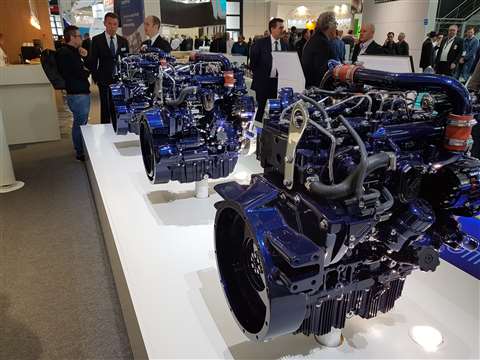
Oliver Lythgoe from the firm’s product concept marketing division says, “The problem with gaseous fuels and the problem with electricity is largely the same – getting it to the machine that’s working on a building site, possibly in a rural area, away from infrastructure.” Added to that, he says, “Squeezing enough gas and storing it on a machine gives the same kind of problem as storing electricity on a machine.”
Describing the work being done by researchers in both biofuels and all-electric equipment, he says, “They’re making good progress, and I do applaud that innovation, but I don’t see it as a mass solution at this point.
“One potential way forward is that people will continue to use something a bit like the latest diesel engines, but they will decarbonise through different fuels.”
Perkins recently unveiled its range of concept hybrid engines; namely hybrid-electric, hybrid-mechanical and hybrid-hydraulic models.
At the first showing, product introduction manager Paul Dixon reinforced Lythgoe’s message, saying, “These engines are designed to improve fuel economy, to enable the downsizing of diesel engines and to reduce running costs.”
In describing the ways in which the different concept engines might help machines be more efficient during various applications, Perkins’ marketing director David Nicoll gave the example a forestry machine, cutting trees.
He said, “The mechanical hybrid has a second flywheel on the engine and that flywheel is gathering power from the engine and storing it. That mechanical flywheel only provides a 10-second power boost, but in that application you don’t even need ten seconds to get through the tree.”

Production of Bobcat’s zero tail swing E10e electric mini-excavator for 2019 has already sold out
Clearly, there is an array of methods through which customers and operators can improve efficiency and reduce fuel usage, whatever that fuel might be. Many contractors, however, will be looking for methods of aiding their bottom line that do not involve a dramatic change in work methods or significant outlay for new equipment.
Exercising efficiency
Volvo recently launched the EcoOperator training programme which it says can help to dramatically reduce both fuel consumption and machine wear, as well as having a significant positive impact on the environment.
Volvo explains that, when companies put their employees through the one-day course, they are unlocking new skillsets to help them make their machines more efficient.
Although machines in drive mode are restricted to using ‘half gas’, for example, they can still take on the same workload and complete work at the same rate. This means fuel costs can be cut by up to 25%, improving company profits and reducing environmental impact. On a global scale, Volvo says EcoOperator training is reducing yearly fuel consumption by up to 35,000 litres.
Volvo has also built fuel saving technology into its machines, with elements including auto idling, auto engine shutdown and eco mode.
Beyond this, Volvo offers a fuel efficiency report to help customers maximise the fuel efficiency of their machines, using data from the CareTrack telematics system. Sensors monitor fuel consumption and reports are automatically compiled by Volvo’s pre-defined algorithms, and then presented in PDF format.
In this way, customers can quickly identify areas where fuel efficiency can be improved, set targets and monitor progress.
Global powerfuels
As both governments and the industry look forward to the possibility of construction sites with ultra-low or even zero emissions, alternative fuels will increasingly be of interest.
In June this year, Global Alliance Powerfuels – a cross-industry alliance of companies and associations, launched by the Germany energy agency, dena – presented to many of Europe’s political and business leaders, guidelines for the development of a global market for electricity-based renewable fuels.
These powerfuels are synthetic, gaseous or liquid fuels generated from renewable energy sources, including wind and solar power.
The organisation’s suggestions for achieving what it calls ‘climate-friendly competition’ in the energy market included EU states taking on pioneering roles to give powerfuels a better chance on the market. One of the measures suggested included the consistent application of the ‘polluter-pays’ principle. The reduction of subsidies for fossil fuels and taxation were also put on the table.
The chief executive of dena, Andreas Kuhlmann, said, “Synthetic, renewable energy sources are the third pillar of a successful energy transition. After all, energy efficiency and the direct use of renewable electricity alone will not make it possible to cover future energy demand in a carbon-neutral way.”
The research undertaken by dena, along with a series of other scientific studies, highlight the role of power fuels as what the organisation calls “the missing link for ambitious global climate protection”.
Kuhlman said, “Now is the time to use and develop the existing know-how, initiate large-scale projects, and open up a sustainable future market.”
There is no doubt that, from an emissions perspective, but also an efficiency and productivity standpoint, the debate about construction’s fuel for the future is gaining momentum.




